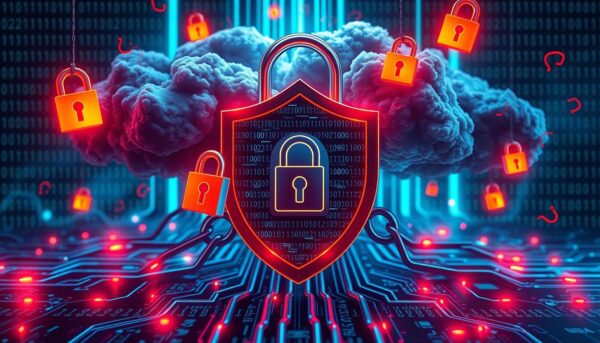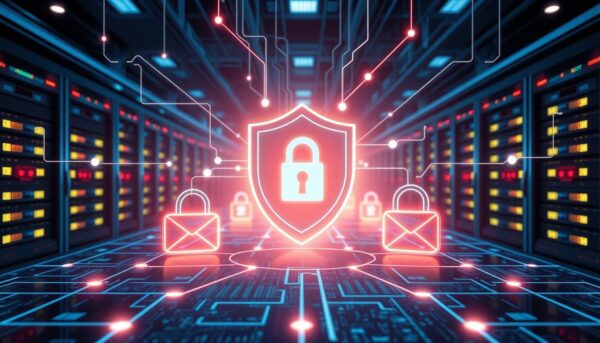✅ Last checked on
Ever felt a sinking feeling after clicking on an email link? It might not be legit. You’re not alone. Phishing scams are a big problem in our digital world, making us feel vulnerable.
But, you can protect your network and personal info from these scams. With the right knowledge and tools, you can stay safe.
Phishing scams are a serious threat to your online security. They aim to steal important data like passwords and credit card numbers. The damage can be huge, leading to identity theft that’s hard to fix.
In fact, over 80% of organizations have faced phishing attacks. This shows how common these threats are.
But, there’s good news. You can protect yourself and your network. By knowing how cybercriminals work and using strong email security, you can lower your risk. This guide will show you how to spot suspicious emails and set up advanced security.
Staying safe online is not just about tech. It’s also about being informed and careful. So, let’s learn how to keep our digital lives safe from phishing threats.
Key Takeaways
- Phishing attacks aim to steal sensitive information like passwords and financial data
- Over 80% of organizations faced phishing attempts in the past year
- Identity theft from successful phishing can take years to recover from
- Email security is crucial in preventing phishing attacks
- Education and vigilance are key components of network phishing protection
- Implementing multi-factor authentication can prevent 99.9% of automated attacks
- Regular security awareness training significantly reduces phishing vulnerability
Understanding the Threat of Modern Phishing Attacks
Phishing attacks are a big threat to businesses today. In fact, 74% of organizations faced phishing attempts in 2022. These attacks aim to steal sensitive information or install malware by tricking users into clicking malicious links or downloading harmful attachments.
Common Types of Phishing Scams
Cybercriminals use various phishing techniques to target organizations:
- Email phishing: The most common type, accounting for 94% of malware delivery
- Spear phishing: Targeted attacks focusing on specific individuals or groups
- Whaling: High-stakes attacks aimed at executives or key decision-makers
How Cybercriminals Execute Phishing Attacks
Scammers craft deceptive messages that often exploit current events or trends. They might claim suspicious account activity or offer fake invoices. A staggering 83% of phishing emails create a sense of urgency to prompt immediate action. Cybercriminals also use misleading domain names in 20% of attacks to appear legitimate.

The Real Cost of Successful Phishing Attempts
The impact of phishing attacks can be devastating. On average, a successful attack costs businesses around $1.6 million. This includes financial losses, data breaches, and long-term reputational damage. Implementing strong phishing defense measures is crucial for protecting your network.
| Phishing Impact | Statistics |
|---|---|
| Organizations affected | 74% |
| Cyber attacks starting with phishing | 91% |
| Average financial loss | $1.6 million |
| Phishing emails opened | 43% |
To protect your network, focus on comprehensive malware protection and web filtering solutions. These tools, combined with employee training, can significantly reduce your vulnerability to phishing attacks.
Network Phishing Protection Fundamentals
Protecting your network from phishing attacks is key in today’s digital world. Phishing makes up 90% of cyber attacks. So, it’s vital to use strong Advanced Threat Prevention strategies. Let’s look at the basics of keeping your network safe from these threats.
First, make sure your security software is current. Set it to update automatically to fight new threats fast. This simple action can greatly lower your risk of phishing attacks.
Use strong Anti-Phishing Measures like email filters and web content analysis. These tools can stop harmful content before it hits your inbox. Since 43% of phishing emails are opened, these steps are crucial.
- Use robust firewalls to protect your network
- Employ email filtering systems to block suspicious messages
- Implement real-time link analysis to check URLs
- Use behavioral analysis to spot oddities
Don’t forget about employee training. It can cut phishing incidents by 70%. Teach your team to spot email scams and report any odd activities quickly.
“The best defense against phishing is a well-informed user combined with advanced technology.”
By learning these basics, you’ll build a strong defense against phishing. Stay alert and keep your network safe against growing cyber threats.
Identifying Suspicious Email Communications
Spotting phishing emails is key to protecting your network. With Network Security Solutions in place, you still need to stay alert. Let’s look at some red flags in email content, sender patterns, and risky links.
Red Flags in Email Content
Watch out for urgent messages or requests for personal info. Legitimate companies won’t ask for sensitive data via email. Poor spelling and generic greetings like “Dear Valued Member” are also warning signs. If an email creates panic about account issues, be wary.
Suspicious Sender Patterns
Check the sender’s email address carefully. Phishers often use domains that look similar to real ones. For example, @clients.amazon.org instead of @amazon.com. This mismatch is a clear red flag.
Dangerous Link and Attachment Indicators
Hover over links to see their true destination before clicking. Be cautious of unexpected file types in attachments. Remember, 30% of phishing emails contain malicious links rather than attachments.
| Phishing Indicator | Frequency |
|---|---|
| Emails with spelling errors | 90% identified as phishing |
| Emails requiring immediate action | 50% response rate |
| Spoofed email addresses | 30% increase in success rate |
If you suspect a phishing attempt, don’t open attachments or click links. Contact your IT team immediately. A Secure Email Gateway can help filter out many of these threats, but staying vigilant is crucial.

“The best defense against phishing is a combination of technology and human awareness.”
Essential Security Measures for Your Network
Protecting your network from phishing attacks is key in today’s digital world. By using important security steps, you can greatly improve your cyber security. This helps keep your sensitive information safe.
Implementation of Multi-Factor Authentication
Multi-factor authentication (MFA) adds a strong layer of protection to your accounts. It requires users to give two or more verification factors. This makes it very hard for cybercriminals to get into your accounts without permission. Turn on MFA for all your network accounts to boost your network’s phishing defense.
Regular Software Updates and Patches
Keeping your software current is crucial for strong network security. Updates and patches fix holes that phishers could use. Make sure all your systems and apps update automatically. This keeps you safe from new threats.
Secure Email Gateway Solutions
Using a secure email gateway is a big part of keeping your emails safe. These tools block bad emails before they get to you. This cuts down the chance of phishing attacks. A strong email gateway stops spam, malware, and phishing.
Remember, network security is always a work in progress. Keep checking and updating your security steps to fight off new threats. With these key security steps, you build a strong defense against phishing attacks.
Employee Training and Security Awareness
Your staff is key in fighting phishing. With 70% of data breaches caused by human mistakes, training is vital. Let’s look at how to make your team more security-aware.
Good security training teaches your team about new phishing tricks. Use interactive lessons and fake phishing tests to keep them alert. Also, update them regularly on new threats.
Training does more than just protect your network. It also helps your team stay safe online at home.
“An organization’s human firewall is its strongest defense against phishing attacks.”
Here are some interesting facts:
- Only 11% of businesses teach cybersecurity to non-tech employees
- 1 in 3 data breaches are phishing attacks
- 20% of companies got hacked because of a remote worker
Spending on employee training is worth it. The cybersecurity training market is set to hit over $10 billion by 2027. This shows how important people are in fighting phishing.
| Impact of Security Awareness | Percentage |
|---|---|
| Data breaches involving human element | 70% |
| Breaches caused by human error | 95% |
| Organizations experiencing phishing attacks | 88% |
By focusing on training and awareness, you’re not just defending your network. You’re creating a strong team that can spot and stop phishing attacks. This makes your whole cybersecurity much stronger.
Immediate Response to Phishing Incidents
Even with strong Anti-Phishing Measures, phishing attacks can still happen. It’s important to act fast to limit damage and keep your network safe. Here’s what to do if you think you’ve been phished.
Steps to Take After Clicking a Suspicious Link
If you’ve clicked a suspicious link, stay calm. Immediately disconnect your device from the internet. Then, run a full antivirus scan and change all your passwords from another device. Remember, 43% of users have clicked on a phishing link at least once in their careers.
Reporting Procedures
Tell your IT security team about the incident right away. They will check the situation and apply the right Network Security Solutions. Make sure employees know how to report potential threats. Quick reporting can greatly lessen the attack’s impact.
Data Recovery and Account Security
After an attack, focus on getting back your data and securing accounts. Use backups to restore lost data. Also, turn on multi-factor authentication for all accounts – it can cut down unauthorized access by up to 99.9%. Keep a close eye on your accounts for any odd activity.
Remember, 90% of successful data breaches come from phishing attacks. By acting fast and following these steps, you can greatly lower the risk of serious damage to your network and data.
| Action | Impact |
|---|---|
| Disconnect device | Prevents further network compromise |
| Change passwords | Secures accounts from unauthorized access |
| Enable MFA | Reduces unauthorized access by 99.9% |
| Report incident | Allows for quick implementation of security measures |
Conclusion
Network phishing protection is key in today’s digital world. Phishing attacks are increasing, with 73% of organizations hit in the last year. You must be alert and ready to defend.
Phishing isn’t just about random emails anymore. Now, attacks like spear phishing and whaling target specific people or high-level executives. These tactics have caused huge losses, from $100 million to $75.8 million. Your network’s safety depends on its weakest point.
To strengthen your cyber security, use multiple defenses. Spam filters and secure email gateways can block fake messages. Also, enable multi-factor authentication to stop unauthorized access. Most importantly, keep training your employees. With one in 2,000 emails being a threat, your team must spot and report suspicious emails fast.
By taking these steps, you’ll lower your risk of falling prey to phishing attacks. Stay updated, be ready, and protect your digital space from phishing scams.